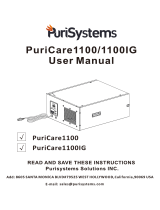OPERATING INSTRUCTIONS
INTRODUCTION
Parts of the machine ....................................................................4
Accessories ....................................................................................... 5
Optional accessories from INSPIRA™ .................................... 6
PREPARATIONS
Connecting the foot control and the power supply ........7
Setting up the spool stand ........................................................7
Setting up the telescopic thread stand ................................8
Front cover .......................................................................................8
Open ..............................................................................................................8
Close .............................................................................................................. 8
Attaching the waste tray .............................................................8
Presser foot lift ............................................................................... 8
Changing the presser foot .........................................................9
Needle information .......................................................................9
Changing the needles ..................................................................9
Movable upper cutter ...............................................................10
Disengaging, position B ......................................................................10
Engaging, position A ............................................................................10
2-thread overlock converter ....................................................10
Engaging ................................................................................................... 10
Disengaging .............................................................................................10
Upper looper .................................................................................11
Disengaging .............................................................................................11
Engaging ................................................................................................... 11
Changing to coverstitch table B ............................................11
Stitch À nger lever setting .........................................................11
THREADING
General threading information ..............................................12
Threading the upper looper (red) .........................................13
Threading the lower looper (yellow) ....................................14
Threading chainstitch looper (purple) ................................15
Threading the right needle .....................................................16
Threading the left needle ........................................................17
Threading the chainstitch needle .........................................18
Threading the coverstitch needles .......................................19
Threading the right coverstitch needle ........................................19
Threading the middle coverstitch/chainstitch needle ...........20
Threading the coverstitch left needle ...........................................21
Needle threader ...........................................................................22
Changing thread ..........................................................................22
TOUCH SCREEN
Touch screen overview ..............................................................23
Select a stitch ................................................................................23
Recommendations ................................................................................23
On-screen stitch adjustments ................................................24
Thread tension .......................................................................................24
Differential feed ......................................................................................24
Stitch length ............................................................................................24
Sewing speed ..........................................................................................24
Save Stitch ......................................................................................25
Personal Name .......................................................................................25
Delete personal stitch ..........................................................................25
Load Stitch .....................................................................................25
Settings menu ...............................................................................26
Display contrast .....................................................................................26
Sound .........................................................................................................26
Language .................................................................................................. 26
Calibrate touch screen ........................................................................26
Info System ....................................................................................26
Pop-ups ...........................................................................................27
STITCHES & SEWING TECHNIQUES
Stitch overview ..............................................................................28
Start sewing ...................................................................................33
Pin Placement ........................................................................................33
Chain off ....................................................................................................33
Rolled edge sewing .....................................................................34
Coverstitch sewing ......................................................................34
Machine set up .......................................................................................34
Start sewing .............................................................................................34
Securing the coverstitch seam end ...............................................34
Flatlock sewing .............................................................................35
Standard Á atlock stitch .......................................................................35
Ornamental Á atlock stitch .................................................................35
Ladder stitch ...........................................................................................35
Chainstitch sewing ......................................................................36
Machine set up .......................................................................................36
Start and end of sewing .....................................................................36
Sewing hints ..................................................................................36
Pintuck sewing .......................................................................................36
Sew in Circles ..........................................................................................36
Securing the thread chain .................................................................36
Braiding by chaining off .....................................................................36
Lowering the needle(s) .......................................................................36
STITCH ADJUSTMENTS
Stitch width adjustment ...........................................................37
Width adjustment by changing needle position ......................37
Width adjustment with the cutting width dial ...........................37
Presser foot pressure adjustment ........................................37
Stitch length adjustment ..........................................................37
Differential feed adjustment ...................................................38
Gathered overlock (stretch, knit fabrics) .....................................38
Stretch overlock (lightweight fabrics) ...........................................38
Thread tension À ne tuning ......................................................39
MAINTENANCE
Machine maintenance ...............................................................41
Cleaning .................................................................................................... 41
Cleaning the touch screen .................................................................41
Oiling ..........................................................................................................41
Replacing the movable upper cutter ............................................41
Storage .............................................................................................42
Servicing ..........................................................................................42
Trouble shooting ..........................................................................42
Machine speciÀ cations ..............................................................43
Intellectual Property ...................................................................43





















